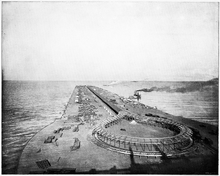Moving walkway
A moving walk (colloquially also a flat escalator , treadmill , moving or rolling sidewalk ) is a means of transport for people, similar in use to a conveyor belt , but the usable area here is not a belt or belt, but consists of metal segments. In terms of construction, a moving walk is therefore more similar to an escalator (escalator), although the metal segments do not form steps, but a flat surface. Moving walks can be designed horizontally or at an angle .
Moving walks and escalators are standardized in European standard EN 115.
history
The oldest known plan for a moving moving walkway comes from the architect Eugène Hénard for the 1889 World Exhibition in Paris. After this project could not be realized, the world's first moving walkway was installed at the World Exhibition in Chicago in 1893 , at that time called a step train in the German trade press . "The Great Wharf" consisted of two separate lanes: an inner lane, on which the passengers could sit and an outer lane, on which the visitors stood or walked. The moving walkway looped the length of a pier in the port of Chicago.
A structurally identical step train was operated at the Berlin trade fair in 1896 . The street of the future was presented
at the World Exhibition in Paris in 1900 . The "Rolling Footpath" was 3.5 km long and had nine access stations.
The first public walkway was installed in Jersey City in 1954 at the Pavonia Terminal, a train station of the Port Authority Trans-Hudson . The band built by Goodyear was named " Speedwalk ". With a length of 84.5 m and a 10% incline, the walkway reached a speed of 2.4 km / h.
The first moving walkway in an airport was installed in Love Field in Dallas, Texas in 1958 .
In 1970 Georg Kohlmaier and Barna von Sartory proposed "Rolling Sidewalks" for Berlin, which were supposed to replace motorized individual traffic in a pipe system above street level.
use
Horizontal moving walks are often used in railways or airports to make it easier for passengers to get to the terminals on long journeys. Inclined moving walks are mainly found in supermarkets with several levels, since, unlike escalators, they can also be used with shopping carts . The rollers of the shopping trolleys must be matched to the profile of the pallets of the moving walk so that the shopping trolleys can fix themselves automatically. The gradient of inclined moving walks must not exceed 7 ° or 12.3% in order to be considered barrier-free . The Tower of London uses a treadmill to funnel visitors past the Crown Jewels that would otherwise be a bottleneck for the flow of visitors.
technology

More modern moving walks have a variable speed . Shortly after entering, the speed of movement of the segments increases to approx. 1.8 times and falls back to normal shortly before leaving. Technically, this is achieved in that the intermeshing metal segments are pulled apart or pushed together in the transition areas. There are various ways of doing this. In one approach, the segments are connected to one another like scissors and only every second one is coupled to the drive chains; By narrowing or widening the track width between the two drive chains, the moving walkway accelerates or slows down. Another approach uses drive chains that fold in the slow zones and stretch in the fast zone. This enables speeds of up to 2 m / s (7.2 km / h) to be achieved.
Web links
Individual evidence
- ↑ Movable Sidewalk , chicagology.com
- ^ History of Moving Walkway , elevator history
- ↑ http://kohlmaier-architekten.de/projects/post-oil-citty/
- ↑ DIN 18024-1 stairs, escalators, ramps, lifts
- ^ ThyssenKrupp Elevator: ThyssenKrupp Airport Systems on growth track. Important acquisition in the passenger boarding bridges business. (No longer available online.) In: thyssenkrupp-elevator.com. April 11, 2006, archived from the original on July 12, 2012 ; accessed on May 22, 2014 (English). Info: The archive link was inserted automatically and has not yet been checked. Please check the original and archive link according to the instructions and then remove this notice.
- ↑ FAZ.net October 28, 2014: Are you still walking or are you already flying?

